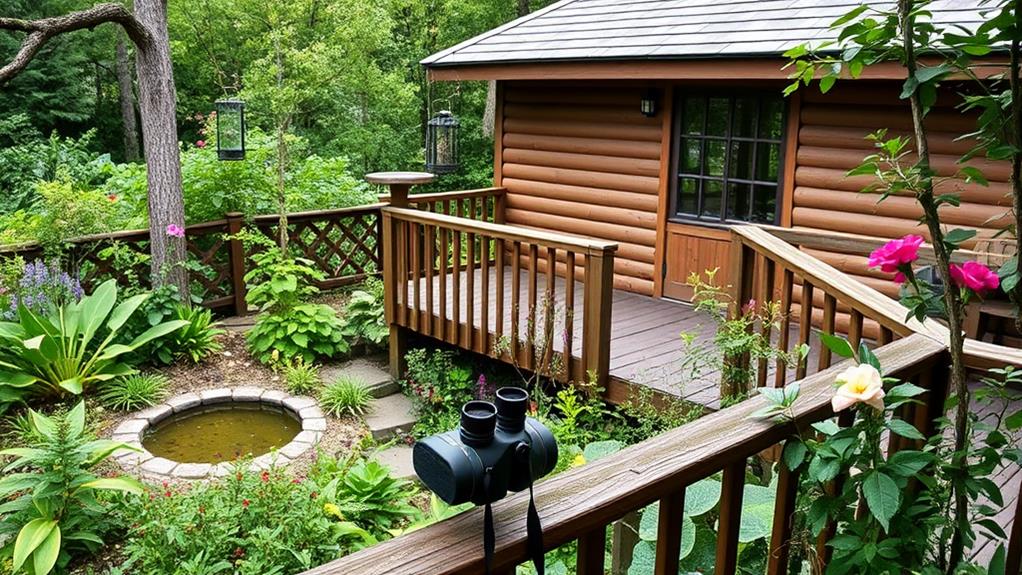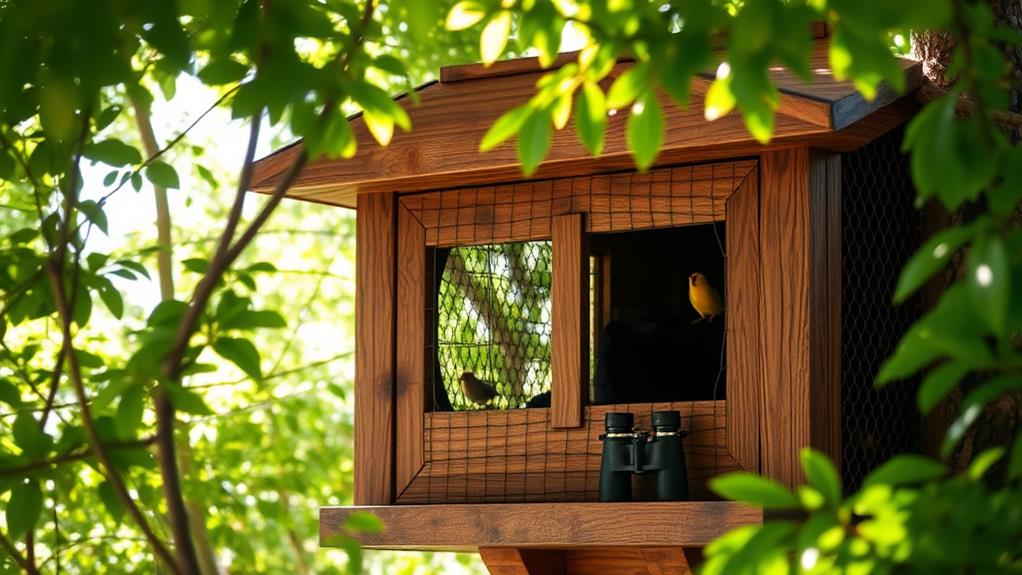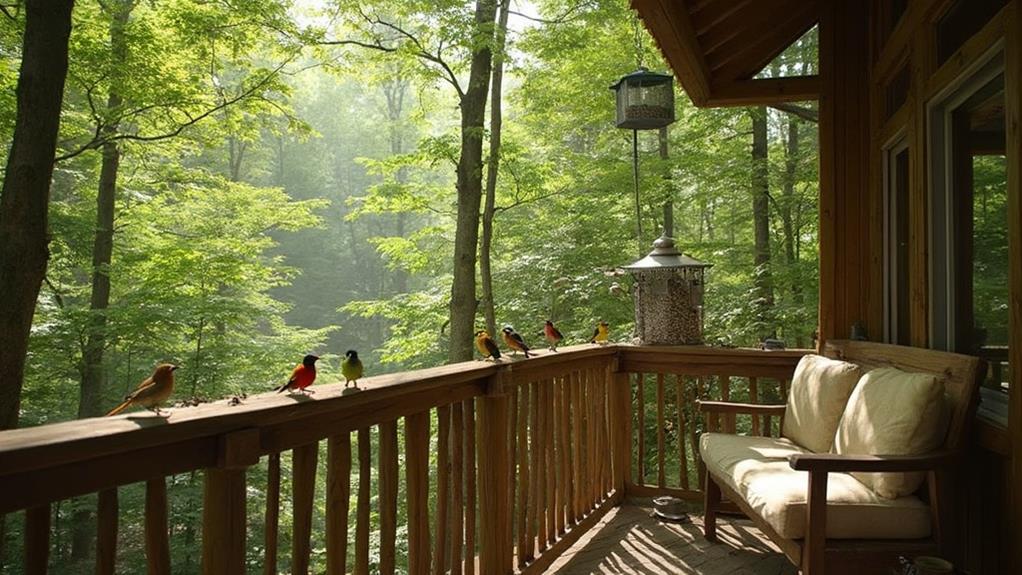Renovating for wildlife watching involves strategic design choices to create optimal nature observation points. Key elements include carefully positioned windows, hidden viewing platforms, and wildlife-friendly garden layouts. Large, well-placed windows offer unobstructed views, while hidden platforms provide secluded vantage points. Balconies can be transformed into observation decks with sturdy railings and native plants. Backyard blinds offer concealed viewing opportunities, and water features attract diverse wildlife. Thoughtful garden design incorporates native plants, layered vegetation, and microhabitats to support local ecosystems. By integrating these elements, homeowners can create immersive wildlife-watching experiences right from their living spaces. Discover how to transform your home into a nature lover's paradise.
Strategic Window Placement

Strategic window placement can make or break a wildlife-watching experience. When renovating for optimal wildlife observation, carefully consider the positioning of windows to maximize viewing opportunities. Large, unobstructed windows facing prime habitat areas provide the best vantage points for observing animals in their natural environment.
Install windows at varying heights to accommodate different viewing angles and wildlife species. Ground-level windows offer excellent views of small mammals, reptiles, and ground-feeding birds, while higher windows are ideal for observing tree-dwelling creatures and airborne species. Consider using bay windows or corner windows to create panoramic views and increase the field of vision.
Implement soundproofing measures to minimize disturbance to wildlife and enhance the viewing experience. Double-paned or triple-paned windows with low-emissivity coatings can reduce noise transmission and improve insulation. Additionally, strategically place windows away from high-traffic areas of the home to create quiet observation zones.
Integrate window seats or built-in benches near wildlife-viewing windows to provide comfortable seating for extended observation periods. Install discreet storage solutions nearby for binoculars, field guides, and other wildlife-watching equipment, ensuring easy access without cluttering the space.
Hidden Viewing Platforms
While strategic window placement offers excellent viewing opportunities, hidden viewing platforms take wildlife observation to the next level. These carefully designed structures provide an immersive experience, allowing observers to get closer to nature without disturbing the local fauna.
Hidden viewing platforms can be integrated into various areas of your property, such as elevated decks, secluded corners of the garden, or even tree houses. The key is to blend these structures seamlessly with the surrounding environment using natural materials and camouflage techniques. Platforms can be constructed with weathered wood, covered in local vegetation, or painted in earth tones to minimize visibility.
When designing hidden viewing platforms, consider incorporating features like one-way glass, strategically placed openings, and sound-dampening materials. These elements enable observers to remain concealed while maximizing their field of view. Additionally, equip platforms with comfortable seating, stable surfaces for camera equipment, and weatherproof storage for field guides and binoculars.
To enhance the effectiveness of hidden viewing platforms, integrate them with other wildlife-friendly landscaping elements, such as water features, native plantings, and feeding stations. This approach creates a holistic environment that attracts diverse wildlife species and provides optimal observation opportunities.
Garden Design for Wildlife

Thoughtfully designed gardens play a crucial role in attracting and supporting wildlife. When planning a garden for wildlife observation, consider incorporating a diverse range of native plants that provide food, shelter, and nesting sites for various species.
Create layers of vegetation, including ground cover, shrubs, and trees, to mimic natural habitats and offer protection for wildlife.
Include water features such as birdbaths, ponds, or shallow streams to attract a wider variety of animals. These not only provide drinking water but also serve as bathing spots for birds and habitats for aquatic creatures.
Incorporate rock piles, logs, and brush heaps to create microhabitats for insects, reptiles, and small mammals.
Design your garden with open spaces and strategically placed plants to create clear sightlines for wildlife viewing. Consider installing raised beds or berms to improve visibility of ground-dwelling animals.
Avoid using pesticides and opt for organic gardening methods to maintain a healthy ecosystem. Finally, provide supplementary food sources like bird feeders and nectar-rich flowers to attract specific species and enhance your wildlife watching experience.
Balcony Observation Points
Balconies offer unique opportunities for wildlife observation in urban and suburban environments. With careful planning and design, these elevated spaces can be transformed into excellent vantage points for watching birds, insects, and small mammals.
To create an effective balcony observation point, consider installing a sturdy railing with a flat top surface for mounting binoculars or spotting scopes. Add comfortable seating that allows for extended periods of quiet observation.
Incorporate plants native to your region to attract local wildlife. Use a variety of containers and hanging baskets to maximize space and create diverse habitats. Install bird feeders, baths, and nesting boxes at different heights to encourage avian visitors. For insect observation, include flowering plants that attract pollinators like bees and butterflies.
To minimize disturbance to wildlife, use privacy screens or strategically placed plants to create a visual barrier between the observation area and the rest of the balcony. Consider installing subtle lighting for nighttime observation of nocturnal species. Keep a field guide and notebook handy for identifying and recording sightings. With these modifications, a balcony can become an ideal spot for urban wildlife watching.
Backyard Blinds and Hides

Numerous wildlife enthusiasts find that backyard blinds and hides are essential tools for observing animals in their natural habitats without causing disturbance. These structures provide concealment, allowing observers to blend into the environment and witness wildlife behavior up close.
When designing a backyard blind or hide, consider factors such as location, size, and materials. Choose a strategic spot that offers a clear view of frequented wildlife areas, such as feeding stations or water sources. Construct the blind using natural materials like wood or camouflage fabric to minimize visual impact. Ensure adequate ventilation and comfortable seating for extended observation periods. Include small, strategically placed viewing windows or slits to minimize movement when taking photographs or using binoculars.
For added versatility, consider a portable blind that can be easily relocated. This allows for adaptation to seasonal changes in wildlife patterns. Incorporate sound-dampening materials to reduce noise and prevent startling animals. Finally, outfit the blind with essential gear like a sturdy tripod, field guides, and a notebook for recording observations. With careful planning and construction, backyard blinds and hides can significantly enhance the wildlife watching experience.
Water Features for Animal Attraction
How can water features enhance wildlife attraction in your backyard? Water is essential for all living creatures, and incorporating various water sources can significantly increase the diversity of wildlife visiting your property. By providing different types of water features, you create microhabitats that cater to various species' needs.
Consider installing a shallow birdbath for smaller birds and butterflies, ensuring it's placed near shrubs or trees for quick escape routes. For ground-dwelling animals, a ground-level water source or small pond can be attractive. Larger ponds can support aquatic life and draw in amphibians and waterfowl.
Moving water, such as a small fountain or waterfall, adds visual interest and creates soothing sounds that mask human noise, making the environment more appealing to wildlife.
When designing water features, prioritize safety by including gradual slopes or escape routes for animals. Maintain cleanliness by regularly changing the water and cleaning the containers to prevent disease transmission. Surrounding your water features with native plants can provide additional cover and food sources, creating a comprehensive wildlife-friendly habitat in your backyard.
Lighting for Nocturnal Viewing

Proper lighting can open up a whole new world of wildlife observation after dark. Nocturnal creatures like owls, bats, and many mammals become active during these hours, offering unique viewing opportunities. However, it's crucial to implement lighting solutions that minimize disturbance to wildlife while enhancing visibility for observers.
Low-intensity, warm-colored lights are preferable, as they're less disruptive to animals' natural behaviors. Red or amber LED lights are excellent choices, as most nocturnal animals are less sensitive to these wavelengths. Consider installing motion-activated lights to reduce constant illumination. Strategically place lights to illuminate specific areas of interest, such as feeding stations or water features, while avoiding direct lighting of nesting or resting areas.
Shielded fixtures that direct light downward help prevent light pollution and protect the night sky. This approach also reduces glare, improving the overall viewing experience. For more flexibility, use adjustable spotlights that can be redirected as needed. Incorporate dimmer switches to fine-tune brightness levels, allowing for optimal viewing conditions while minimizing impact on wildlife. Remember to consult local regulations regarding outdoor lighting, as some areas have specific requirements to protect nocturnal ecosystems.
Sustainable Materials and Practices
When renovating for wildlife watching, incorporating sustainable materials and practices is essential for minimizing environmental impact and promoting long-term ecological health. Choose locally sourced, renewable materials like bamboo, reclaimed wood, or recycled plastics for construction. These options reduce carbon footprint and support regional economies. Implement energy-efficient systems, including solar panels or wind turbines, to power observation areas and reduce reliance on fossil fuels.
Utilize water conservation techniques, such as rainwater harvesting and xeriscaping, to maintain the surrounding landscape without depleting local water resources. Install permeable pavement or gravel paths to manage stormwater runoff and prevent erosion. Incorporate green roofs or living walls to provide additional habitat for local flora and fauna while improving insulation.
When selecting finishes and furnishings, opt for low-VOC paints, sustainably harvested wood, and recycled fabrics. Implement waste reduction strategies during construction and ongoing operations, including composting and recycling programs. By prioritizing sustainable materials and practices, wildlife watching renovations can enhance the natural environment while providing meaningful observation experiences for visitors.
Frequently Asked Questions
How Can I Soundproof My Observation Area to Avoid Disturbing Wildlife?
To soundproof your observation area, consider installing acoustic panels, utilizing sound-absorbing materials like carpets or curtains, and sealing gaps around doors and windows. Double-paned glass and insulated walls can further reduce noise transmission, minimizing disturbance to wildlife.
What Permits Are Required for Constructing Wildlife Viewing Structures on My Property?
Just as a bird builds its nest with care, constructing wildlife viewing structures requires proper planning. Permits vary by location, but often include zoning, building, and environmental permits. Check with local authorities for specific requirements in your area.
How Do I Handle Unexpected Wildlife Encounters During Renovation or Observation?
When encountering unexpected wildlife during renovation or observation, remain calm and avoid sudden movements. Slowly back away, giving animals space. Never approach or feed wildlife. Contact local wildlife authorities if an animal appears injured or aggressive.
Are There Liability Concerns When Inviting Guests to My Wildlife Viewing Areas?
Yes, there are potential liability concerns when inviting guests to wildlife viewing areas. Property owners should consider obtaining appropriate insurance coverage, posting safety warnings, and having visitors sign liability waivers to mitigate risks associated with wildlife encounters.
How Can I Photograph Wildlife Without Specialized Equipment From My Observation Points?
Like a patient hunter, success in wildlife photography requires stillness and strategy. To capture great shots without specialized gear, use your smartphone's zoom, hide behind natural cover, and employ burst mode for action-packed moments.
Conclusion
Integrating wildlife observation features into home renovations creates a symbiotic relationship between human dwellings and natural habitats. Like a well-tuned instrument in an orchestra, each element—from strategically placed windows to sustainably designed gardens—harmonizes to attract and protect local fauna. By implementing these thoughtful modifications, homeowners not only enhance their living spaces but also contribute to conservation efforts, fostering a deeper connection with the environment and promoting biodiversity in urban and suburban landscapes.

